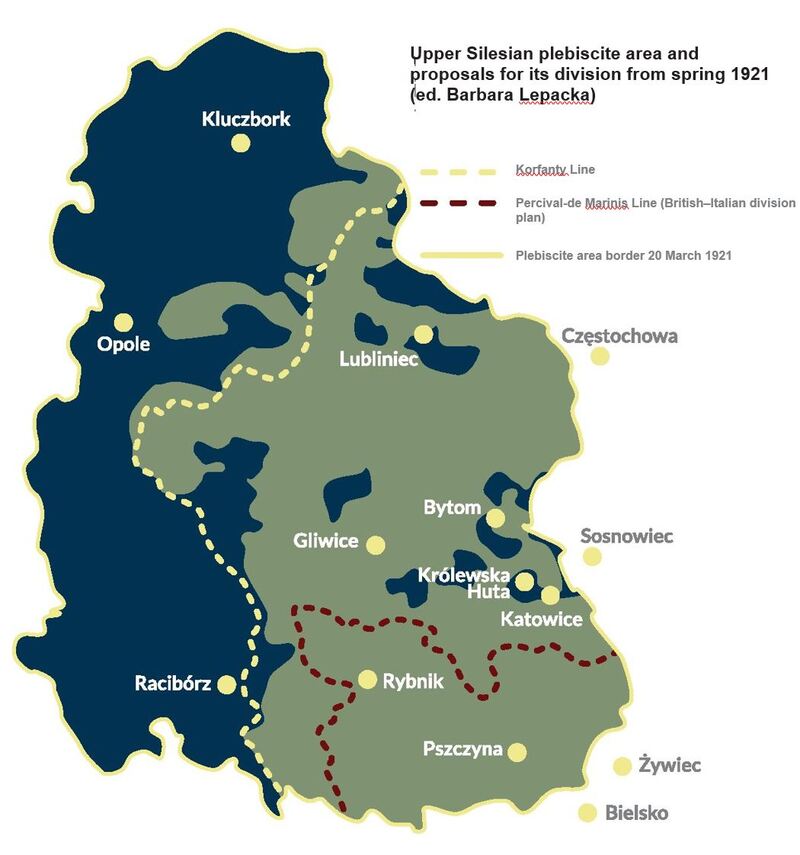Contrary to expectations, the plebiscite did not settle the issue of Upper Silesia decisively. The ambiguous results of the vote led both Poles and Germans to interpret them in their favour. As early as 22 March 1921, Wojciech Korfanty, as the Polish Plebiscite Commissioner, issued a proclamation which read, ‘Compatriots! We have won a great historic victory in the struggle for the national belonging of Upper Silesia and the freedom and happiness of the Polish people. We have not managed [...] to gain the whole territory of Upper Silesia, but what we did gain is the most valuable part of it. In vain are the recent German prevarications, which try to convince the residents of Upper Silesia and the world that Upper Silesia is one indivisible whole and that the absolute majority of votes in the entire plebiscite territory decides on where Upper Silesia belongs’.
This was followed by a listing of the exact course of the proposed border line dividing the plebiscite area into the eastern part, which was to be adjoined to Poland, and the western part, which was to be allocated to Germany. The argument in favour of dividing the disputed areas was to be the fact that over 70 % of the municipalities in the eastern part of the plebiscite area voted for Poland, and proponents of uniting the disputed area to the Polish state obtained an absolute majority of votes. The demarcation line, named the Korfanty Line after the Plebiscite Commissioner, was to run from the Czechoslovak Bohumín, along the Oder River, and then north-east along the the Groß Strehlitz (Strzelce Opolskie) district, partly through the Oppeln (Opole) district, and farther along through the Rosenberg (Olesno) district to the Polish border. The Polish side would include 59.1 % of the disputed territory inhabited by 70.1 % of the population, along with the entire industrial district.
On the basis of the plebiscite results, the German government demanded restoration of authority over the entire plebiscite area, refusing to consider the loss of any districts, even those where a decisive majority voted for Poland.
Several days after the plebiscite, newspapers reported that the resolution of the Upper Silesian issue was up to the Allied Supreme Council, an executive body of the Peace Conference comprising the heads of government of the great powers, to which the Inter-Governmental and Plebiscite Commission would propose drawing a new border between Poland and Germany, taking into account the geographic and economic situation of individual towns.
The Polish press urged calm, arguing that any attempts to fight could change France’s favourable attitude. Polish Prime Minister Wincenty Witos, in a letter to Wojciech Korfanty, expressed his hope that after the case was soon settled in the international forum, ‘Upper Silesian Poles will be reunited with Poland, welcomed with the greatest joy by the whole Republic of Poland’.
In mid-April, the matter of Upper Silesia was taken up in Paris at a meeting of the Parliamentary Commission for Foreign Affairs, during which the French Prime Minister Aristide Briand proposed that the entire eastern plebiscite area, along with the ‘industrial triangle’ should be annexed to Poland, leaving the entire agricultural area to Germany. Great Britain, supported by Italy, consistently proposed dividing the territory in such a way that the industrial area would remain wholly within German borders.
In the absence of compromise, the chairman of the Inter-Governmental Commission, General Henri Le Rond, sent two entirely conflicting proposals for the division of Upper Silesia to the forum of the Supreme Council. The British–Italian proposal, called the Percival–de Marinis Line, after the names of the countries’ representatives in the Inter-Allied Commission, was decidedly unfavourable to Poland, as it left the industrial area and most of the plebiscite area to Germany. The Polish side would include only the Pleß (Pszczyna) and Rybnik districts, a fragment of the Ratibor (Racibórz) district, and small fragments of the Polish border-adjacent Tost-Gleiwitz (Gliwice), Hindenburg (Zabrze), Beuthen (Bytom), Lublinitz (Lubliniec) and Rosenberg (Olesno) districts). In total, this was 25.6 % of the plebiscite area, inhabited by 21 % of the population, and excluded the largest Upper Silesian cities or industrial plants. The French proposal, presenting a modified Korfanty Line under the name Le Rond Line, differed only slightly from the Polish concept. Poland was to receive the entire industrial district, but Germany would keep some areas in the north-east of the plebiscite territory, where they won the majority of the votes. The border would run along the Oder River; however, the western part of the Groß Strehlitz (Strzelce Opolskie) district would remain on the German side. In the northern section, the border cut through the Lublinitz (Lubliniec) district, with the town of Lubliniec remaining on the Polish side and the town of Guttentag (Dobrodzień) on the German side. North of Guttentag (Dobrodzień), the eastern fragment of the Rosenberg (Olesno) district would be incorporated into Poland.
Poles had already received alarming news through diplomatic channels that the Supreme Council did not intend to consider the partition concept proposed by France and that the chances of the Percival–de Marinis line being recognised as the future border were growing. The official review of both proposals was to take place at the beginning of May, at a Council meeting held in London. In this situation, Wojciech Korfanty, with the support of Upper Silesian politicians, having the approval of the Polish government, the aid of the Polish army, and the unofficial support of Gen. Le Rond, made the decision to begin the uprising on the night of 2 May.
Renata Skoczek
IPN Katowice
